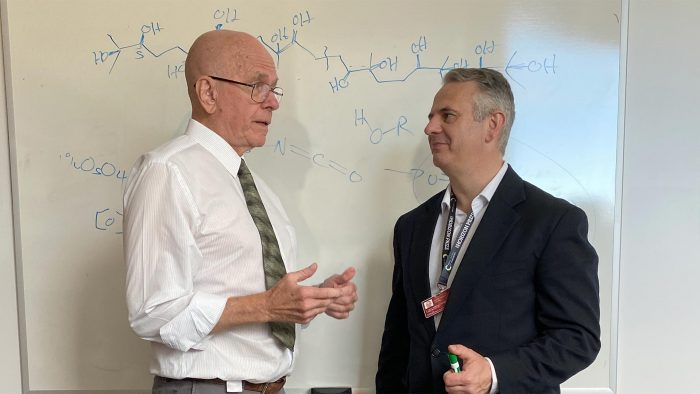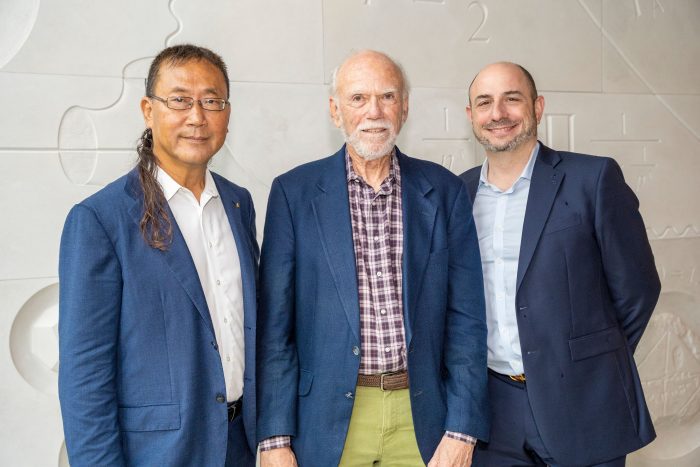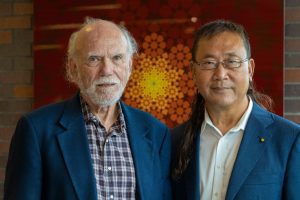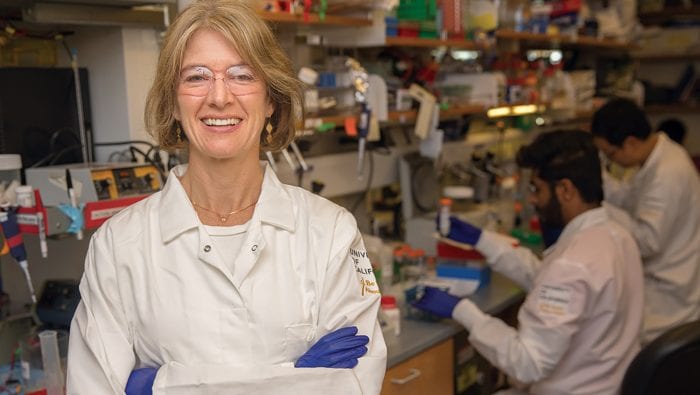By Daniel Dunaief
K. Barry Sharpless changed John Moses’s life. And that’s before Moses even started working as a postdoctoral researcher in Sharpless’s lab.
When Moses, who is the first chemist to work at Cold Spring Harbor Laboratory in its 132-year history, was earning his PhD in chemistry at Oxford, he read an article that Sharpless co-authored that rocked his world.
Nicknamed the “click manifesto” for introducing a new kind of chemistry, the article, which was published in Angewandte Chemie in 2001, was “one of the greatest I’ve ever read,” Moses said, and led him to alter the direction of his research.
Moses walked into the office of the late chemist Sir Jack Baldwin at Oxford, who was Moses’s PhD advisor, and announced that Sharpless, a colleague of Baldwin’s at the Massachusetts Institute of Technology, was the only chemist he wanted to work with in the next phase of his career.
Baldwin looked at Moses and said, in a “very old-fashioned gangster English, ‘That shows you’ve got some brains,’” recalled Moses.
Sharpless was important not only to Moses’s career, but also to the world.
Recently, Sharpless, who is the W.M. Kepp Professor of Chemistry at Scripps Research, became only the fifth two-time recipient of the Nobel Prize.
Sharpless will share the most recent award, which includes a $900,000 prize, with Carolyn R. Bertozzi, the Anne T. and Robert M. Bass Professor in the School of Humanities and Sciences at Stanford University, and Morten P. Meldal, professor at the University of Copenhagen, for the invention of a type of chemistry that has implications and applications from drug discovery and delivery, to making polymers, to developing anti cancer treatments.
The way click chemistry works is that chemists bring together catalysts and reagents, often attached to sulfur or carbon, that have a high level of specific attraction for each other. The click is like the sound a seat belt makes when secured, or the click a bike helmet lock makes when the two units are connected.
Scientists have often described the click reaction as being akin to LEGO blocks coming together, with an exact and durable chemical fit.
Natural product synthesis is generally challenging and often requires complex chemistries that are not always selective. This type of chemistry can produce side reactions that create unwanted byproducts and require purification.
Click reactions, by contrast, are selective and reliable and the products are generally easy to purify. Sometimes, purification is as simple as a water wash.
“It’s a democratization of synthetic chemistry,” Moses said.
Moses said biologists have performed click reactions. Chemists have developed click tablets that can be added to a reaction to create a plug and play system.
Moses described the reactions in click chemistry as “unstoppable” and suggested that they are part of a “domino rally” in which a latent build up of reactivity can create desired products with beneficial properties.
Moses, who arrived at CSHL in 2020, has collaborated with several researchers at the famed lab. He is submitting his first collaborative paper soon with Dr. Michael Lukey, who also started in 2020 and performed his PhD at Oxford, and Dr. Scott Lyons. He is also working on a New York State Biodefense funded project to create shape shifting antibiotics that can keep up with drug resistance pathogens.
He has collaborated with Cancer Center Director David Tuveson to develop a new ligand to target a protein important in pancreatic cancer. Moses said they have a “very exciting” lead compound.
Early resistance
While the Nobel Prize committee recognized the important contribution of this approach, the concept met with some resistance when Sharpless introduced it.
“When [Sharpless] submitted this, the editor called colleagues and asked, ‘Has Barry gone crazy?’” Moses said.
Some others in the field urged the editor to publish the paper by Sharpless, who had already won a Nobel Prize for his work with chirally catalyzed oxidation reactions.
Still, despite his bona fides and a distinguished career, Sharpless encountered “significant resistance” from some researchers. “People were almost offended by it” with some calling it “old wine in new bottles,” Moses said.
In 2007, Moses attended a faculty interview at a “reasonably good” university in England,. where one of his hosts told him that click chemistry is “just bulls$#t!”
Moses recognized that he was taking a risk when he joined Sharpless’s lab. Some senior faculty advised him to continue to work with natural product synthesis.
In the ensuing years, as click chemistry produced more products, “everyone was using it and the risks diminished quickly,” Moses added.
Unique thought process
So, what is it about Sharpless that distinguishes him?
Moses said Sharpless’s wife Janet Dueser described her husband as someone who “thinks like a molecule,” Moses said.
For Moses, Sharpless developed his understanding of chemistry in a “way that I’ve never seen anyone else” do.
Moses credits Dueser, who he described as “super smart,” with coining the term “click chemistry” and suggested that their partnership has brought together his depth of knowledge with her ability to provide context.
Moses believes Sharpless “would admit that without [Dueser], his career would have been very different! In my opinion, [Dueser] contributed immeasurably to click chemistry in so many ways.”
Indeed, click chemistry won a team prize from the Royal Society of Chemistry last year in which Dueser was a co-recipient.
As for what he learned from working with a now two-time Nobel Prize winner, Moses said “relinquishing control is very powerful.”
Moses tells his research team that he will never say “no” to an innovative idea because, as with click chemistry, “you never know what’s around the corner.”
Moses said Sharpless is a fan of the book “Out of Control” by Kevin Kelly, the co-founder of Wired Magazine. The book is about the new biology of machines, social systems and the economic world. Sharpless calls Kelly “Saint Kevin.”
On a personal level, Sharpless is “humble and a nice person to talk to” and is someone he would “want to go to a pub with.”
Moses believes Sharpless isn’t done contributing to chemistry and the world and anticipates that Sharpless, who is currently 81 years old, could win another Nobel Prize in another 20 years.
An inspirational scientist, Sharpless ” is “that kind of person,” Moses said.









